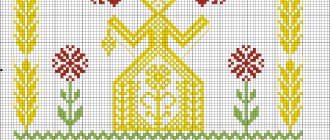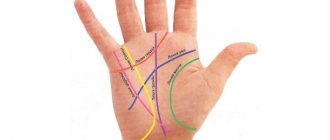Dolya and Nedolya are 2 great spinners. determining the fate of every person. In modern speech, we often use the words happiness and misfortune, luck and failure, fate and not fate. Heavenly spinners are assistants to the Goddess of Fate - Makosh
. His fate largely depends on who spins a person’s thread.
In ancient times, the word “god” was used to mean share, fate or happiness.
The heavenly spinner is the goddess of fate Makosh. Path of Destiny
She spins threads and winds them into a ball. Not ordinary threads - magical ones. Our life is woven from those threads - from the beginning - birth - to the end, to the final denouement - death. Even the gods bow before her, just as they all obey those unknown threads of Mokosh.”
(“Songs of the Bird Gamayun”)
The heavenly spinner - the goddess Makosh is responsible for “spinning” the threads of fate. As the goddess of fate, Makosh determines those milestones2 that must inevitably happen in our lives. The paths of fate on the canvas of life help Mokosh to “embroider” her assistants Dolya and Nedolya.
The word “fate” contains at its root the word “court,” which suggests its constant connection with karma, the law of cause-and-effect relationships, by which a person judges himself.
So, the goddess Makosh spins the “fabric” of a person’s life, and Dolya and Nedolya tie the threads of the causes and consequences of those actions that were committed by a person, events appointed by fate. Dolya (or Srecha), sitting on the right hand of the Mother Goddess Mokosh, ties knots on the thread of fate in accordance with the good deeds of a person, which will shine as happy moments in life, while Nedolya (or Nesrecha), sitting on the left hand of Mokosh, ties knots of events that will appear in life as consequences of negative deeds based on a person’s selfish motives, and will inevitably turn into difficult trials of fate.
“And her assistants, Share and Nedoleya, on those threads, without looking, tie little knots: for good fortune or for ill, only Mokosha knows this.”
(“Songs of the Bird Gamayun”)
Do you believe in fate, which predetermines everything that happens in our lives, or do you think that a series of events develops on its own, by chance? The concepts of fate and karma are closely interrelated - in Sanskrit, fate is indicated by the word kárman (कर्मन्). Everything that we have done in past incarnations, one way or another, will become a lesson for us in new births, and these lessons, tied in knots on the thread of fate by the goddess Makosh, are determined by her for each of us. The good seeds of what we have done will bear good fruits, and the bad ones will sprout into the field of our life with sorrows and sorrows. She spins the thread of a person’s destiny, taking into account all the karmic preconditions that were formed in his past life.
Destiny is also influenced by the tendencies and inclinations of all individuals who were embodiments of our soul - in Sanskrit referred to as skandhas. They have a special effect on consciousness and accompany a person from life to life. This “set” of unique traits, habits, and interests shapes our destiny in accordance with what is imprinted in it. Everything is taken into account by the wise patroness of fate, goddess Makosh - nothing is hidden from her omnipresent gaze...
As Yoga Vasishtha says, pure tendencies lead us to Liberation, while impure tendencies drag us down and lead to various troubles. And we ourselves have the power to decide which of them we will strengthen and which ones we will weaken.
Therefore, there is no evil Fate, for no reason destined for us as the “blind arbitrariness” of the gods. There are no coincidences - everything in our world manifests itself naturally. There is no need to complain about injustice, since fate is the consequence of our actions, and only we ourselves bear responsibility for what happens to us, for everything is rewarded according to what we deserve. The conditions in which we find ourselves now are the result of our past actions in previous lives, and our current actions create the fate of our future incarnations on earth. Therefore, all the main events in life, one way or another, are predetermined and depend on the karmic prerequisites created by the actions of past incarnations, and in subsequent lives they manifest themselves as lessons that we need to go through. That is, certain circumstances were determined karmically in which we must demonstrate free will. A person is always given the opportunity to choose which path to follow. The predetermination of fate, its fatalism, manifests itself only within the framework of key events in life, and how we manifest ourselves in these circumstances depends on how well we have learned the lessons of karma. Spiritual development occurs thanks to such lessons from the school of life, the “schedule” of which is predetermined by fate, ordained by the goddess Makosh.
“What is called fate or God's will is simply the result of past actions, personal efforts in the past. The present is infinitely more powerful than the past. Only fools are satisfied with the results of their past efforts and do not make any efforts in the present.”
(“Yoga Vasishtha”)
Certain key events of life, as they are otherwise called - milestones of fate - these are the knots on the thread of fate, tied by Makosh and her assistants Dolya and Nedolya. They determine the fate of a person from birth to death. They are inevitable, and the path a person will follow in the current life circumstances depends entirely on his voluntary choice. Mother Makosh always leaves us the freedom to choose the path in life: we will follow the Right path of goodness and good aspirations commanded to us by the gods and our ancestors, or we will deviate from the direct path of the Rule and follow the road that leads away from the light of the divine Iriy into the darkness and gloom of ignorance and vice. Life tests us - whether we have learned a lesson from the past, whether we learn from our mistakes or repeat them again from life to life. Therefore, karmic consequences largely shape our destiny.
The actions themselves do not always become the cause of karmic consequences - more than the act itself, the motivation for its accomplishment affects karma and fate. The same action has different karmic consequences depending on the motives, the internal urge - what we are guided by when making a certain choice to do one way and not another. How we act depends on our attitude towards the situation that has arisen in life.
Vedic instructions - not to become attached to the results of our actions - call us to pay attention to the essence of the motives of our actions: if a person strives to obtain the fruits of his actions, it means that he has an internal incentive for this action - to gain a certain benefit. Even a noble aspiration, if there is attachment to the result and a desire to “see” the fruits of one’s actions, hides personal interest. It is important not to fall into the trap of the mind and be able to discern the true motives of our actions. As long as there is a sense of “I” in a good deed and joy from the feeling of personal participation in a good deed, until then the deed cannot be true good.
Before any bright undertaking in life, it is extremely important to determine and sincerely answer the question - what motivates you, what is your true motivation. Based on this, it will become obvious why you took this path. Are you acting from noble motives or are you looking for some kind of benefit for yourself personally? What are the purpose and motives for action - is it accomplished from selfish motives or from the desire to bring benefit to everyone? Each action is assessed from the point of view of the internal motives leading to the action.
Day and night, the heavenly loom of the goddess Mokosha carries out its “fateful” activity, on which she weaves the fabric of every person’s life. Fate is a kind of “training” program in the school of life, in which we are given the opportunity to learn the lessons that we need on the path of spiritual self-improvement. Karma, which forms the main milestones of fate, is a purifying force, good for the Spirit, but bad for a selfish person who keeps the bright Spirit in the prison of ignorance and obscurations. All karmic connections manifest themselves at certain moments in life at a favorable time to learn the lessons of fate, to show us a picture of how we behaved towards other living beings - we must experience all this fully on ourselves and feel the pain caused to others and suffering. Fate is called upon to return us to the path of Rule, from which we probably once left and determined our lives by the existing karmic consequences.
Many, not wanting to admit that they are responsible for their fate, also begin to blame other people who create problems in their lives and create obstacles in the implementation of their plans. Any meeting is not accidental. There is nothing random in life at all, everything is natural. We should not forget that every person we meet on the path of life is our teacher. With the help of all the people around us, life also teaches us.
The occurrence of specific situations in life is not scheduled by time or clock. There is only a certain predetermined series of events, through which a person learns to make decisions based on the experience gained from all past incarnations. An event can occur several times in life until a person develops the right attitude towards it, until he learns a lesson. This may not happen during manifest existence - earthly life, then in the afterlife we also have the opportunity to learn from the mistakes made during life, which will form the “grain of karma”, which subsequently manifests itself in our destiny. A certain circumstance in life will be repeated until the lesson is completed. As soon as you realize why this situation is given to us, and that everything depends only on us, you will understand that there is no point in changing something on the outside, it is important to make internal transformations in yourself, which will lead to changes in circumstances in external life. Living life this way consciously, we gradually “untie” the knots on the thread of fate, carefully tied by Mother Makosh for our own good.
By the way, in this context it would be important to mention the advisability of observing certain austerities and other self-restraints without a clear understanding of their true meaning. Because an unconscious violent limitation of desires will only create the preconditions for the desire to satisfy them with even greater zeal.
“Impure tendencies must be gradually abandoned, and the mind must turn away from them gradually, so as not to provoke a strong reaction.”
(“Yoga Vasishtha”)
Until at a deep level we realize the futility of encouraging the selfish tendencies that arise in us, getting rid of desires and passions cannot be achieved by any restrictions. The ban will help expand the influence of the limiting factor on our consciousness, which will subsequently inevitably lead to the desire to fulfill what we once desired. Not by limiting desires, but by transforming them into the highest spiritual intentions of creative creation, it is possible to overcome these shackles of overwhelming passions and selfish motivations for behavior. It is important to realize that it is not the suppression of lower feelings, but the awakening of higher aspirations that leads us to a new step on the ladder of the evolutionary ascent of the Spirit. This way, negative tendencies will gradually go away, and the desires caused by them will gradually cease to influence our consciousness. In this way we build our destiny today - and for the future incarnation we create good living conditions for spiritual development.
By comprehending the lessons of fate, we gradually unravel knot after knot, thereby preventing the possibility of predetermined events caused by karmic consequences influencing us later in life. As Yoga Vasishtha confirms:
“Efforts can be of two categories - the efforts of past births and the efforts of this birth. The latter can defeat the former. Destiny is nothing but the efforts of past births. There is a constant conflict between these categories in this incarnation, and the stronger ones win. Therefore, we must, gritting our teeth, make efforts to overcome evil with good, and fate with efforts in the present.”
It is believed that when a person begins to see clearly and is finally freed from false selfhood and the shackles of attachment, the goddess Makosh unties all the knots on the thread of his destiny.
Goddess of women's creative creative work
As a heavenly spinner - in the same aspect, Makosh appears as the goddess of various types of women's needlework. Not only weaving, knitting, embroidery, as one might assume, but also other types of women’s crafts, through which a woman endows everything she creates with her creative energy. Makosh is the patron of all craftswomen doing handicrafts. As you know, creative creative manual labor leads to the acquisition of inner harmony, calms, creates peace and harmony in relationships with others and develops such important and necessary qualities for any woman as patience, hard work, humility, perseverance and attentiveness. The very creative process of creating beauty is fraught with exceptional benefit - it leads us to the ennobling of feelings and balancing the inner and outer worlds.
Share – Goddess of easy fate
In literature and paintings, Dolya is depicted as a young maiden in elegant clothes. Share is a skilled spinner, her thread of fate is smooth, strong, and beautiful. The hair is styled in a braid, beautiful, cheerful and gentle. According to legend, Dolya can turn away from a person if he leads an unrighteous life, complains about life, or is lazy. In order not to anger Dolya, people tried to maintain a good mood and not give up under any circumstances.
Share walks around the world, strives to help a person in everything, helps him through life. Those who are patronized by Share are lucky in all matters in life. In addition, it is the Share that endows the born person with talents and luck.
People believed that if the thread of fate was woven by Dolya, everything in life would go smoothly. When her older sister Nedolya gets involved, poverty and illness cannot be avoided. In rare cases, fate can be changed to a kinder one. There are even special rituals.
However, if a person initially did not get along with the good Dolya, he will have to live with Nedolya. At the same time, Nedolya do not always come to those who have done something terrible; sometimes they can punish for the deeds of their ancestors. Therefore, the life of each person is reflected not only in our destiny, but also in the destiny of children, grandchildren and great-grandchildren. By our actions we can call Nedolya on our children.
Makosh - goddess of prosperity and fertility
The cult of the goddess Mokosh, who shows maternal care for all creation, is associated with the veneration of the Mother of the Raw Earth, as a life-giving force that gives grace-filled gifts to her children. Appearing in the aspect of Mother Earth - the stronghold of the Explicit World, Makosh appears in the form of a nurse, giving a rich harvest, caring for all living beings.
Patroness of the hearth, goddess of family well-being and prosperity, guardian of the harvest (this hypostasis can be traced in the etymology of the name Makoshi: “ma” - mother, “kosh” - home).
In this aspect, like the goddess Lada - the keeper of the hearth, caring for all the children of the Mother of the Raw Earth, Makosh appears as the goddess of well-being, prosperity and abundance. The Goddess Makosh is especially favorable to working women who are busy with the housework, creating the comfort and warmth of the hearth.
Makosh also favors everyone who works tirelessly, putting their souls into their work and creating for the benefit of the prosperity of the family. By the way, according to popular belief, Mokosh’s messengers are insect workers: spiders, bees, ants.
Goddess Makosh - patroness of the water element
Makosh is also revered as the patron goddess of the water element. In the Russian Vedic tradition, Mother Water acts as a life-giving, cleansing force, a maternal, life-giving element. In this incarnation, Makosh appears as the mistress of all water sources, rivers, lakes, seas, oceans, as well as wells - the guardians of water used by a person in household life. The goddess Makosh among the Western Slavs, in particular among the Czechs, was revered as the goddess of rain and dampness; in difficult times of drought and crop failure they called upon her as a savior, bringing fertile moisture, saturating the soil and preserving the harvest. Makosh, who appears in her incarnation as Zhiva - the goddess of all life in the Open World, is the goddess of living water. While appearing with a dark face as the goddess Madder, she is the personification of dead water.
Makosh - mother giving birth
Makosh, which is a manifestation of the female hypostasis of a single divine essence, personifies the female life-giving principle. The Mother Goddess, protector of the universe, is revered in many cultures and traditions. Like a mother who gives life to her child, so the Mother Goddess Makosh, who laid the foundation for all things, is the force that supports the existence of all life in the universe. Our ancestors especially revered birthing mothers, who are hypostases of the Great Mother of the Universe, who manifests herself in different faces in the images of beautiful goddesses of the Russian Vedic pantheon. In addition to the eldest woman in labor - the goddess Mokosha, women in labor are also the mother of the gods Svarozhichi and people Lada, who gave birth to the disembodied spirits Lelya, the life-giving force - the goddess Zhiva. In this incarnation, acting as the Mother-Generator, Makosh appears in various faces (revealed as her daughters): Dolya (aka Zhiva or Srecha) and Nedolya (Mader or Nesrecha).
Two faces of the goddess Mokosha
The great goddess Makosh, united in her two faces - as the embodiment of the dual female nature, weaves the fabric of life for each person from the yarn of fate. And it is not by chance and merciless lot that it falls to a person by fate to live his life in a way that they do not want, but at the behest of the goddess Mokosha, the law of retribution is fulfilled, which measures out the happiness and sorrow experienced in life to everyone according to his deeds.
In the life of every person, moments arise that require special endurance from him in overcoming the adversities of fate. Some do not complain about the fate that befell them, remembering that everything is a consequence of their actions and is at the same time a guarantee of the events of the future life. Others do not seek to learn a lesson from what has befallen them, but try to influence the situation outside or escape from troubles, not realizing that they will inevitably arise in life until a person is able to comprehend their true purpose.
To those who are strong in spirit, do not despair and do not bow under the weight of difficult life circumstances, endure all the blows of fate with dignity, strive to create and create for the benefit of all living beings (for a truly righteous person cannot be happy until others are happy) - to them Makosh sends his daughter Srecha (Dolya), the goddess of luck and happiness, who accompanies them in all good endeavors and helps them easily overcome all obstacles on the righteous path of life. From the spindle of fate of the goddess Doli comes a straight golden thread - the same way that determines a person’s path in life. And to those who have left the path of Rule and live with selfish thoughts, betray, deceive others, use for their own purposes, another daughter of Mokosh comes to them - Nesrecha (Nedolya), the goddess, from whose spindle a crooked, fragile thread comes - to man predetermining a life path full of sorrows and failures, nevertheless, allowing them to learn the lessons of fate and conducive to their spiritual growth.
As the Russian folk proverb says: “To regret your lot is like looking for wind in an open field.” Therefore, we should not complain about fate, for carefully woven by the goddess Makosh, she leads us to the light of comprehension of the true essence of existence. Everything in our lives, created by the gods of light, serves for the benefit of evolution and our spiritual growth. They return all their children, who have turned away from the right path, disobeyed the orders of their Supreme parents - the gods of light, with lessons marked with knots on the thread of fate to the right path of light.
The bright face of Mokosh is the summer goddess Zhiva (Share, Srecha), personifying the active force of life in the world of Reveal, opposing death, passivity and inertia; the dark face is the winter goddess Mara (Nedolya, Nesrecha), symbolizing death as a transition from one state to another, the power of the Navi world, the other world. Zhiva bestows vitality, and Marena controls the correct use of this gift and takes it away at the destined moment. Therefore, if a person uses his life force for the benefit of all things, then this power is multiplied by the Living Goddess, otherwise Mara takes away the life force, which turns into illnesses and ailments in a person’s life, also called to return us to the path of Rule.
Goddesses of fate in other traditions and beliefs
Goddesses of fate, heavenly spinners who weave the life paths of all living beings with the threads of fate, in the traditions of other peoples appear as: moiras, norns, parks, etc. As a rule, these are three goddesses, the images of which are very similar to the images of the goddess Mokosha and her two daughters ( faces).
According to the legends of ancient Greek mythology, three rulers of destinies live on Olympus - the goddesses Moira, who rotate the heavenly spindle of destinies, revealed as the fundamental principle of all things in the Universe. They determine the fate of gods and people. One of them is the goddess Lachesis, who glorifies the past, and she also takes out the lot that determines what is destined in life. The second goddess spins the thread of the fate of the present - Clotho, revered as the goddess of fate, fortune telling, handicrafts, she measures the life of a person on earth - where the thread breaks, there life ends. And the third Moira, named Atropos, denoting the pattern of the future on the canvas of life, she enters into the scroll of fate everything assigned to a person by her sisters - once she writes fate into the scroll, no one can escape it. In one of the Orphic hymns they are addressed as the inevitable and inexorable all-giving “deliverers of all mortals in misfortune.” Also on Olympus there is the goddess of luck Tyukhe, who from the cornucopia bestows everyone with happy milestones of fate.
In ancient Roman mythology there are also three goddesses of fate, called parkas - Nona, who winds the thread of life on the spindle of fate, Morta, who cuts the thread of life, and Decima, who measures the duration of life. The Romans also revered the goddess Fortuna, who bestows good fortune and good fortune.
The Scandinavian medieval mythological tale "The Younger Edda" tells the story of three goddesses of fate - the Norns, who "judge the fate of people." And the ancient Icelandic song about gods and heroes “The Elder Edda” describes many goddesses-soothsayers, mistresses of destinies, appearing in various guises, but especially highlights three wise maidens who weave destinies and prepare lots, calling them Urd, Verdandi and Skuld. The elder Urd is the goddess of fate, responsible for the past, the mature Verdandi is for the present, and the young Skuld creates the future.
For Lithuanians, one of the seven spindles of fate, weaving on the canvas of life the path that a person is destined to follow, is the goddess Verpeia, who sits in the heavens and connects the stars, personifying the lives of people, with the threads of fate with the firmament - the longer the thread, the longer life. A falling star was a sign that somewhere someone’s life had been cut short, for the goddess of fate cut the thread connecting a person’s soul with life. Thus, according to the beliefs of many Indo-European peoples, each person has his own star in the sky, which shines while he lives his life on earth, and goes out the moment he dies.
Sign and symbol of Mokosh
The goddess Makosh is depicted, as a rule, on embroidery in the form of a female figure with arms outstretched upward. Two birds can be depicted in the hands, or on the sides of Mokosh - two moose cows, symbolizing women in labor, or the conniving goddesses Dolya and Nedolya. Also, symbols of earthly fertility are associated with Makosh in the guise of the patroness of the earthly element. As a rule, these are rhombuses, squares and triangles (top down). All of them also symbolize the maternal protection that the Mother Goddess Makosh gives us.
In particular, the Slavic symbol of the heavenly spinner of fate Mokosh is a geometric figure in the shape of a rhombus, which includes four more small rhombuses, separated from each other by a crosshair. It is believed that such a talisman depicting the symbolic image of Mokosh will bring health, prosperity in the home and family well-being to its owner. It is considered especially effective when a woman puts on clothes with an embroidered Mokosh sign during holidays dedicated to the goddess of fate: Spring, Summer or Autumn Mokosh. In the same aspect, the goddess Makosh is personified by the symbol of fertility - the sign of a sown field, which is used in folk embroidery, but it can also be depicted in any other way when creating a talisman. They embroider rhombuses and rectangles with dots in the middle - “seeds” that sowed the field, usually with beads, draw - with dots, and when carving on wood, small holes are drilled. The goddess of fate is also personified by such symbols as a spindle, a spinning wheel, yarn, and a sheaf of ears of corn (a symbol of the harvest).
LiveInternetLiveInternet
Quote from Bulgakova_Tatyana's message
Read in full In your quotation book or community!
SLAVIC MYTHOLOGY
Link: Source here
Makosh Artist Viktor KorolkovMother of the World. Artist Nicholas Roerich
Makosh or Mokosh, in Slavic mythology, the goddess of fertility and fate (kosh, kosht - fate, the syllable “ma” can be abbreviated as the word “mother”), the eldest of the goddesses, the spinner of fate, as well as the patroness of women’s handicrafts - on Earth; guards women's fertility and productivity, thriftiness and prosperity in the home. It can be correlated with the beliefs of the ancient Greeks in the spinners of fate - the Moira, as well as with the German spinners of fate - the Norns and Frigg - the wife of Odin, spinning on her Wheel. Due to the fact that the goddesses - the spinners of fate in beliefs appear in threes, the Goddesses Dolya and Nedolya help to weave the Yarn of Mokosh’s Fates, connecting with the weaving threads of a person with the fruits of his labors - good or evil.
Share and Nedolya
Artist Viktor Korolkov
Makosh is connected with the Earth (in this her cult is close to the cult of the Mother of the Raw Earth) and Water (which here also acts as a maternal, life-generating environment).
Makosh Artist Andrey Mazin
Makosh is the goddess of fertility, the mother of harvests, has 12 annual holidays, sometimes depicted with horns (apparently the cult of Mokosh - and the Lunar cult, then there were 13 holidays). The characteristic women's horned headdress was worn back in the 19th century during folk festivals. Mentioned in Russian chronicles and numerous teachings against paganism. “Instructions for Spiritual Children” in the 16th century warns: “Bow before the invisible God: people who pray to Rod and women in labor, Perun, and Apollo, and Mokosha, and Peregina, and do not approach any vile demands of the gods.” The only goddess from the pantheon of Prince Vladimir. The mother of the gods, perhaps the wife or incarnation of Veles-Mokos-Mokosh, correlated with Hecate (the name is often used in the masculine gender). “Mamai, the king... began to call upon his gods: Perun, Salmanat, Mokosh, Raklia, Rus and his great assistant Akhmet”; “they put the demand and create... Mokosh’s marvels.... They anoint the goddess Ekatia, they create this maiden and honor Mokosh.” Thus, Makosh is the goddess of witchcraft and the mistress of the Transition from this world to the Other World. In her lower form, she may be the famous Baba Yaga (Hel, Kali), in which case we can say that she is the mother of the winds and the mistress of the forest world. Depicted on Russian embroidery between two moose cows, sometimes depicted with a cornucopia. Perhaps Makosh is an image of the most ancient, still Neolithic origin, Mother Goddess, who is known as the “Neolithic Venus”. The most ancient Goddess was the giver of both life and death; the image of her face was considered taboo; she had a large head.
Mother of the World Artist Nicholas Roerich
Mokosh's Day is Friday, in Orthodoxy the image merged with Paraskeva Friday, i.e. she is the patroness of housewives and wives. One of the days on which Makosh is especially honored is the Friday closest to April 8 - the Prophecy of Mokosh. And also on October 27, Paraskeva Friday itself. Its metal is silver, its stone is rock crystal and the so-called “moonstone”. Mokosh's beast is a cat. The symbol of this goddess is yarn, a ball of wool, a spindle, and they were brought to the temple. Mokosh’s idols could be made from “female woods,” primarily from aspen. The idol of Mokosh could often be horned or have a horn in his hands. Monk Alberich from Three Sources in his “Chronicle” of the 11th century (according to A. Frenzel, 1712) wrote: “II. 1003 Emperor Henry... subjugated the Vindelici, a people bordering the Suevi. These Vindelians revered Fortune; having her idol in a famous place. They put a horn in his hand full of a drink made from water and honey...” Share, Srecha, Sryashta, Meeting, Happiness - a spinner, assistant or younger sister of Mokosha, the mother of the lot, Yagishna. Nedolya, Nesrecha, Nesryashta, Zloschastie - also a spinner, assistant or younger sister of Mokosh.
Mother of the World Artist Nicholas Roerich
So, Makosh herself: 1. Goddess of all Fate 2. Great Mother, goddess of fertility, associated with the harvest, has 12-13 annual holidays (and can be celebrated every full moon) 3. Goddess of magic and sorcery, wife of Veles and Mistress of the crossroads of the universe between worlds . 4. Protector and patroness of housewives. 5. In the lower hypostasis she is the famous Yaga, in this case we can say that she is the mother of the winds, that life and death are equally subject to her. 6. Mistress of Living Nature.
Holidays dedicated to Mokosh
The days dedicated to the goddess Mokosh can be considered the following: Spring Mokosh, which falls on May 9–10; Summer Makoshe, celebrated on July 19; Autumn Makoshe, celebrated on October 14 or 28; Also considered Mokosh days are September 8 and 14, November 1 and 10.
Spring Makoshya, also called Mother's Day of the Raw Earth or Name Day of the Mother of the Raw Earth, since on this day they honor Mother Earth, who awakened in the spring from the cold winter sleep that bound nature. On this Makoshin day, one must show special respect and sensitivity to Mother Earth; one must not disturb her: plow, dig and “bother” her in any other way, since it is believed that the earth is at peace, “resting” on its Name Day.
Summer Makoshya, otherwise referred to as Summer Mokridy, celebrated on the eve of Perun Day (July 20), is also one of the holy days dedicated to Mokosh, appearing in one of her faces - as the element of water. According to folk superstitions, rainy weather observed on this day is a harbinger of a stormy, rainy autumn, and if there is a bucket3 on Summer Mokridy, then the autumn foretells it will be dry. Also, rain on this day promised a rich harvest of rye for the next year. Makosh is revered in her incarnation as the patroness of the water element on this day and is blessed with requests that are presented to her with requests to grant moisture in dry times or to protect from the abundance of rain.
The main day when the Great Goddess Makosh is especially revered is Autumn Makoshya, or Autumn Mokrids. From this day on, Makosh, manifested by his two faces as the elements of earth and water, “falls asleep” for the duration of the long winter. It is customary on this day to bring demands to Mother Earth and Mother Voditsa and ask for forgiveness from them if they have annoyed you in any way in the past year. They also carry out fortune-telling, asking the Spinner Heavenly Makosh, the patroness of fate, about what is in store for her in the future.
Makosh is the patroness of the autumn season, and the month of the year that she patronizes is October. As mentioned above, the main days of Mokosh are the October days that fall on Autumn Mokosh. But also in ancient times, she was revered during the series of days of the “old Indian summer” (from September 1 to September 7) - the so-called Poletye Makoshino.
Also, September 14 is considered the day of the “wedding” of Veles and Marena (the winter hypostasis of Mokosh), when nature begins to wither. As the eldest woman in labor, the goddess Makosh is revered on the day of the Family and women in labor on September 8, on this day they honor not only the Ancestor of the Most High Family, but also all ancestors and relatives, this is a day of family and home well-being.
Appearing in her winter face as Madder, the goddess Makosh is sometimes revered in autumn in the month of November, be it November 1 or 10, when winter comes and envelops nature in a cold haze, remaining under its cover until next spring.
Makosh - wife of the god Veles
Veles's wife, the goddess Makosh, is the governing force on the border of the Explicit and Naval worlds, being the mistress of the transition from one world to another. Makosh represents the female face of the Great and Wise God Veles - the guardian of the Kalinov Bridge, located above the river of oblivion Smorodina (the crossing between the worlds of Reveal and Navi) along which souls pass who have completed their next incarnation on earth. At the end of a person’s life journey, when the thread of life is cut off by the sickle of Mara, which is the dark face of Mokosh, the soul leaves the mortal body and appears before the judgment of the ancestors and Conscience. In the world of Navnoy, in the “pastures of Veles”, the god Veles and the goddess Makosh meet the soul and determine fate in accordance with all the deeds committed during life on earth, so that in the new incarnation a lesson can be learned from what was done in the past. Everyone is measured by Veles and Makosh according to the actions committed in the world of Reveal. Thus, the many-wise Veles leads souls to a new birth on earth, and his wife Makosh weaves the threads of fate along the path prepared for a new life.
In difficult situations in life, many people often grumble at fate, thinking that the gods “don’t love” them and are punishing them. However, everything that the gods on high has prepared for us with parental love goes for the benefit of our spiritual development. It is important not to forget that everything that happens to us now is a consequence of our past deeds, and fate reveals the fruits of what is sown.
“The saints emphasize - consistently follow the Path that leads to true good. And the wise seeker knows: the results of his efforts will be commensurate with the intensity of his own efforts, and neither fate nor God can change this.”
(“Yoga Vasishtha”)
When a person has comprehended the true essence of fate, he no longer perceives it as an evil fate, punishment or test, but accepts it as a good manifestation that certainly serves his spiritual development. Thanks to such a perfect process of our “training” in the school of life, predetermined for us by the patroness of fate, Mother Makosh, we have the opportunity to learn from our own mistakes and grow spiritually.
Makosh - patroness of water service spirits
The wife of the god Veles, who appears as the patron of all domestic and natural4 spirits, usually associated with the element of earth, living on the border of the worlds - between Reality and Navy, the goddess Makosh is the patroness of all water and air spirits. Since, as mentioned above, the goddess Makosh is the patroness of such female elements as earth and water, she is in charge of the world in which mermaids, mermaids, Mavkas, water sisters and other spirits of the interworld, who are the embodiments of the water element, live.
Mokosh Day - a holiday of the ancient Slavs
Mokosh Day is Friday, if we mean the days of the week, and not the only day of the year that is dedicated to this goddess. It is recommended to make amulets with the Mokosh symbol on Friday, on the waxing moon or on the full moon. With the transition to Christianity, they began to identify it with the Orthodox Saint Paraskeva-Friday; perhaps the assignment of the status of Mokosh Day to Friday is connected with this.
According to ancient beliefs, on Friday you cannot do needlework, especially sewing and spinning. According to Christian sources, Saint Paraskeva Friday can appear to violators, stabbing women who decide to break the rule with needles.
There is also information that Makosh was celebrated every full moon. However, according to some sources, the first full moon in May, and sometimes the last one in April, is considered a special day for her admirers.
In addition, October 26 is considered Mokosh Day. It was on this day that our ancestors brought demands to the idols of this goddess or threw yarn or threads into the well. You can also honor the goddess in this way. But you shouldn’t do household chores; she may be offended by non-compliance with ancient traditions. You cannot do needlework, do laundry, or bathe children. In the old days, round dances of two circles were performed around the aspen idols of Mokosh on her day - the outer one spun clockwise, the inner one counterclockwise.











